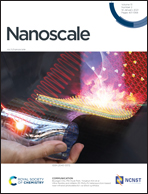Stabilizing the ferroelectric phase in HfO2-based films sputtered from ceramic targets under ambient oxygen†
Abstract
Thin film metal–insulator–metal capacitors with undoped hafnium oxide and a mixture of hafnium and zirconium oxides are prepared by sputtering from ceramic targets. The influence of the oxygen concentration while sputtering and of the zirconium concentration on the ferroelectric properties is characterized by electrical and structural methods. Depending on the ambient oxygen, the thin undoped hafnium oxide films show distinct ferroelectric properties. The interplay of oxygen and zirconia could improve the ferroelectric properties. By varying the ambient oxygen and zirconia concentration in the films, stabilization of the tetragonal, orthorhombic or monoclinic phase is possible. This phase stabilization is strongly influenced by the pre-existing phase and size of the nanocrystallites in the as-deposited films. In conclusion, the impact of the film stress coming from oxygen vacancies and oxygen interstitials is correlated with the phase and ferroelectric properties.



 Please wait while we load your content...
Please wait while we load your content...